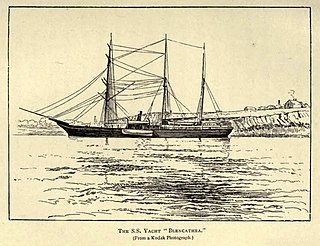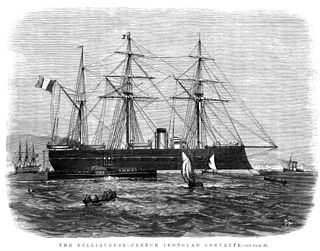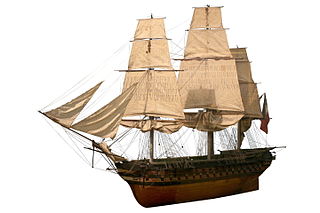
The Shimonoseki campaign was a series of military engagements in 1863 and 1864, fought to control the Shimonoseki Straits of Japan by joint naval forces from Great Britain, France, the Netherlands, and the United States, against the Japanese feudal domain of Chōshū, which took place off and on the coast of Shimonoseki, Japan.

USS Onondaga was an ironclad river monitor built for the Union Navy during the American Civil War. Commissioned in 1864, the ship spent her entire active career with the James River Flotilla covering the water approaches to the Confederate States capital of Richmond, Virginia, although her only notable engagement was the Battle of Trent's Reach. After the war, she was purchased by France where she served as a coastal defense ship in the French Navy.

HMS Euryalus was a fourth-rate wooden-hulled screw frigate of the Royal Navy, with a 400-horsepower (300 kW) steam engine that could make over 12 knots. She was launched at Chatham in 1853, was 212 feet long, displaced 3,125 tons and had a complement of 515. At the time of the Bombardment of Kagoshima she carried 35 guns, not counting approximately 16 carronades. Seventeen of her guns were breech-loading Armstrong guns. She carried 230 tons of coal, and provisions for about three months, together with over 70 tons of shot and shell.
Eleven ships of the Royal Navy have borne the name HMS Unicorn, after the mythological creature, the unicorn:

The Philomel-class gunvesselHMS Newport was launched in Wales in 1867. Having become the first ship to pass through the Suez Canal, she was sold in 1881 and renamed Pandora II. She was purchased again in about 1890 and renamed Blencathra, taking part in expeditions to the north coast of Russia. She was bought in 1912 by Georgy Brusilov for use in his ill-fated 1912 Arctic expedition to explore the Northern Sea Route, and was named Svyataya Anna, after Saint Anne. The ship became firmly trapped in ice; only two members of the expedition, Valerian Albanov and Alexander Konrad, survived. The ship has never been found.

The Cochinchina campaign was a series of military operations between 1858 and 1862, launched by a joint naval expedition force on behalf of the French Empire and the Kingdom of Spain against the Nguyễn period Vietnamese state. It was the opening conflict of the French conquest of Vietnam.

HMS Coromandel was a wooden paddle dispatch vessel of the Royal Navy. She was built for the P&O company as the passenger and cargo steamer Tartar. The Navy purchased her in 1855 and she participated in several battles in Chinese waters, including having been sunk and recovered. The Navy sold her in 1866 and she went through several changes in ownership before she was broken up in 1876.

The French ironclad Belliqueuse was a wooden-hulled, armored corvette, built for the French Navy in the 1860s and designed as a cheap ironclad. She was the first French ironclad to sail around the world, which she did between December 1867 and May 1869. She spent the bulk of her career in the Pacific before returning to Toulon, where she was used as a target in 1886.

Sphinx was a paddle steamer, initially rated as a corvette, of the French Navy, and lead ship of her class. She was the first operational French naval steamer. She took part in the Invasion of Algiers in 1830, pioneering the role of steamers in navies of the mid-19th century, and later took part in the transfer of the Luxor Obelisk from Egypt to Paris.

The French ironclad Magnanime was one of 10 Provence-class armored frigates built for the French Navy during the 1860s. Commissioned in 1865, she was initially assigned to the Northern Squadron, but was soon transferred to the Mediterranean Squadron, often serving as a flagship. The ironclad played a minor role in the Franco-Prussian War of 1870–1871, blockading the North Sea coast of Prussia. Magananime was reduced to reserve after the war, but was reactivated in 1875 and assigned to the Mediterranean Fleet. The ship was decommissioned in 1878 and was stricken from the navy list in 1882. She was scrapped in 1885.

The French ironclad Surveillante was one of 10 Provence-class armored frigates built for the French Navy during the 1860s. Commissioned in 1867, she was initially assigned to the Northern Squadron. The ironclad played a minor role as a flagship in the Franco-Prussian War of 1870–1871, blockading the Baltic and North Sea coasts of Prussia. Surveillante was decommissioned after the war, but was reactivated in 1876. She was transferred to the Mediterranean Squadron the following year.

The French ironclad Valeureuse was one of 10 Provence-class armored frigates built for the French Navy during the 1860s. Commissioned in 1867, she was initially assigned to the Northern Squadron, but was soon transferred to the Mediterranean Squadron, often serving as a flagship. The ironclad played a minor role in the Franco-Prussian War of 1870–1871, blockading the North Sea coast of Prussia and later a Prussian commerce raider in a neutral Spanish port. Valeureuse was reduced to reserve after the war, but was reactivated in 1875 and assigned to the Northern Squadron. The ship was decommissioned two years later and was stricken in 1886. She was scrapped in 1888.

The French ironclad Revanche was one of 10 Provence-class armored frigates built for the French Navy during the 1860s. Commissioned in 1867, she was initially assigned to the Northern Squadron. The ironclad played a minor role in the Franco-Prussian War of 1870–1871, blockading the North Sea coast of Prussia. Revanche was placed in reserve after the war, but was reactivated in 1875, sometimes serving as a flagship. Assigned to the Mediterranean Squadron, she suffered a boiler explosion in 1877 that required extensive repairs and did not return to service until late 1878. The ship was decommissioned in 1883 and served in second-line duties, including service as a guard ship in 1892–1893, until she was stricken in early 1893 and subsequently scrapped.

Guerrière was a sail and steam Dryade-class frigate of the French Navy. She is known as the flagship of Admiral Pierre-Gustave Roze during the French campaign against Korea in 1866.

Ulm was a 100-gun Hercule-class ship of the line of the French Navy. She was transformed into a steam and sail ship while on keel and launched as an 82-gun ship.

The Duguesclin was a 90-gun Ship of the line of the French Navy. She was the second ship in French service named in honour of Bertrand du Guesclin.

Masséna was ordered as a third-rank, 90-gun sailing Suffren-class ship of the line for the French Navy, but was converted to a steam-powered ship in the 1850s while under construction. Completed in 1861 the ship participated in the Second French intervention in Mexico the following year. Hulked in 1879 and used as a barracks ship, the vessel sank at her moorings in 1904 and was subsequently scrapped in place.

The Flamand was a 56-gun Bordelois-class ship of the line of the French Navy. She was funded by a don des vaisseaux donation from the Estates of Flanders, and built by engineer Léon Guignace on a design by Antoine Groignard. She took part in Suffren's campaign during the American Revolutionary War.
Gravel Island (砂利島|Jarijima) is a small, uninhabited island, located in the South China Sea. Gravel Island is part of the Spratly Islands. This coral and volcanic island is the smallest islet and the northwesternmost of a small group of three coral atolls. It has an area of 0.32 hectares, and is mostly composed of loose stone. It is claimed by Japan, the People's Republic of China, and the Republic of China (Taiwan). Gravel Island is the only Spratly Island to be claimed by Japan.

HMS Tartar was a wooden screw corvette of the Royal Navy. Originally built for the Russian Empire, she was seized by British forces on 5 April 1854, shortly before her launch.















